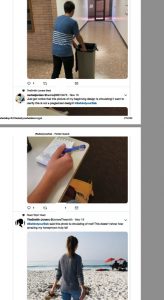Behind Your Bak, a netprov
Apps beg for our attention. Notifications whine, they tease, they bully. They inflame our social curiosity.
In the netprov #BehindYourBak we pretend our fictional characters have been locked out of their accounts by the stupendous mega-network Behind Your Bak — but they’re still getting notifications! Agh! What are people saying?
Create a fictional character in Twitter and let your character’s imagination run wild.
Runs thru Nov 18, 2018
Behind Your Back Archive
How to Play Behind Your Back
- Use the character generator to get your character’s main social media concern (aka netfixation) (http://markcmarino.com/netprov/byb/). The main relationship or issue your character is worried about not being able to see.
- Create a Twitter account for your character or use an existing one. Register the Twitter account to be part of the netprov.
- The story in a nutshell: While locked out of a social media site, your character continues to get notices about what’s going on behind their back, leaving their imagination to fill in the blanks.
- Post your character’s hypothetical theories of what is going on behind their back. Are good things happening? Not? While trying to improve the situation of your character’s main concern, you should make matters worse, sitcom style.
- Check the daily Twitter generic notification feed @behindyourbak for prompts for your writing.
- Tweet a PostEarYour — or shot of your character from behind their back. Let others speculate on what your character was doing (keep it PG, nothing sexual or inappropriate please). (Use original photos only, no faces.)
- As you read others’ stories about what is going on behind their backs, can you figure out why the social media site has locked you all out? Who might have done this? What do you all have in common?
Suggested Plot Arc
Phase 1 (first 20% of time): express frustration at being locked out and your character feeling like the only one.
Phase 2 (middle 50% of time): share with others who are also locked out about your character’s imaginings prompted by the notifications and trying to compensate for the imagined problems — thereby making things worse.
Phase 3 (final 30% of time): continue your characters’ personal stories while collaborating with others to figure out why all have been locked out and develop a plan of action.
Typical PostEarYour


